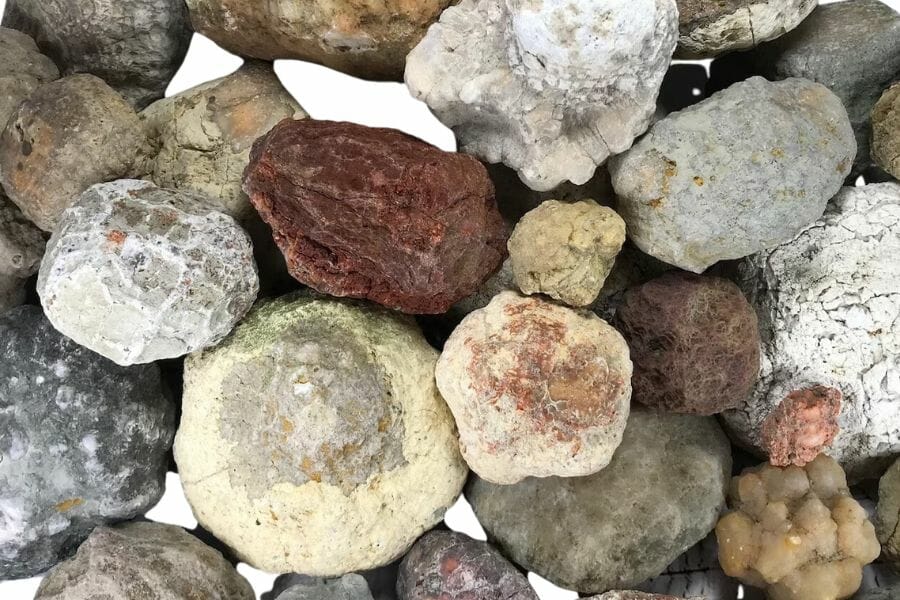If you’re an avid rock collector or simply enjoy unique natural wonders, you may have stumbled upon geodes. Geodes are fascinating rocks that contain hollow cavities filled with crystals, minerals, or other materials but being able to tell if a rock is a geode can be pretty difficult.
Many of us have probably walked right past a geode as we walked down a stream or through a road cut. They can be difficult to spot if you’re not specifically looking for them.
Fortunately, with a few tips and tricks we discuss below, you will be able to spot most of them without a problem. Use these tips in any of our favorite places to find geodes and you are going to have some luck, as long as you’re keeping your eyes open!
What Geodes Are and How They Are Formed
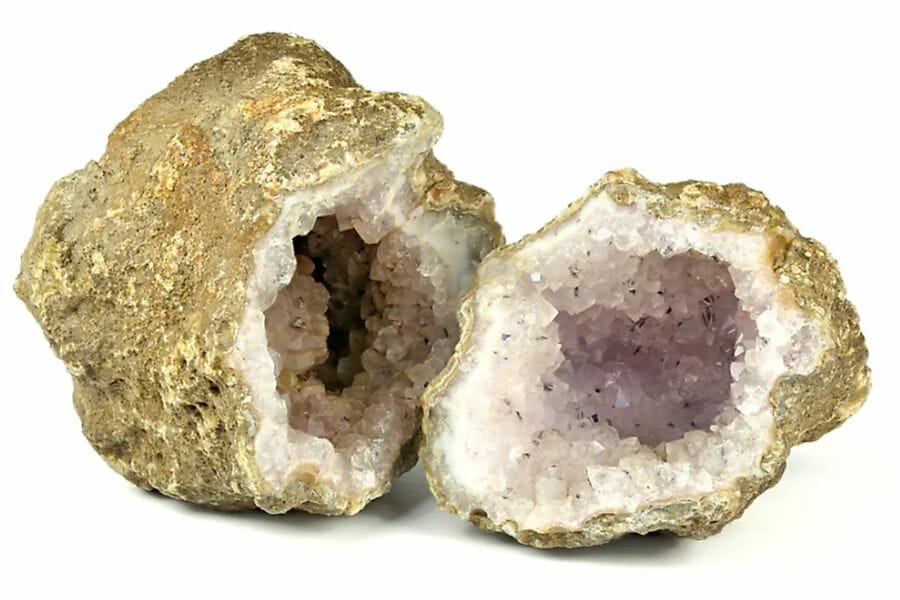
These natural wonders are created when mineral-rich groundwater seeps into a cavity in a rock, such as a hollow space left behind by a gas bubble. The water carries dissolved minerals with it, including quartz, calcite, and amethyst, among others.
Over time, the minerals in the water begin to crystallize and solidify, forming a spectacular display of crystals and minerals inside the rock. The crystals can grow to be several inches long and can take on a variety of shapes and colors, depending on the minerals present and the conditions in which they formed.
Geodes can take anywhere from a few years to millions of years to form, depending on the size and composition of the rock. Some geodes are found in clusters, while others are solitary formations. They come in a variety of shapes and sizes, making each one a truly unique natural wonder.
Geodes have been prized for their beauty and rarity for centuries. In ancient times, they were believed to have healing powers and were often used in spiritual and religious ceremonies. Today, geodes are popular among collectors and are often used in jewelry and home decor.
The Key Characteristic To Spot A Geode
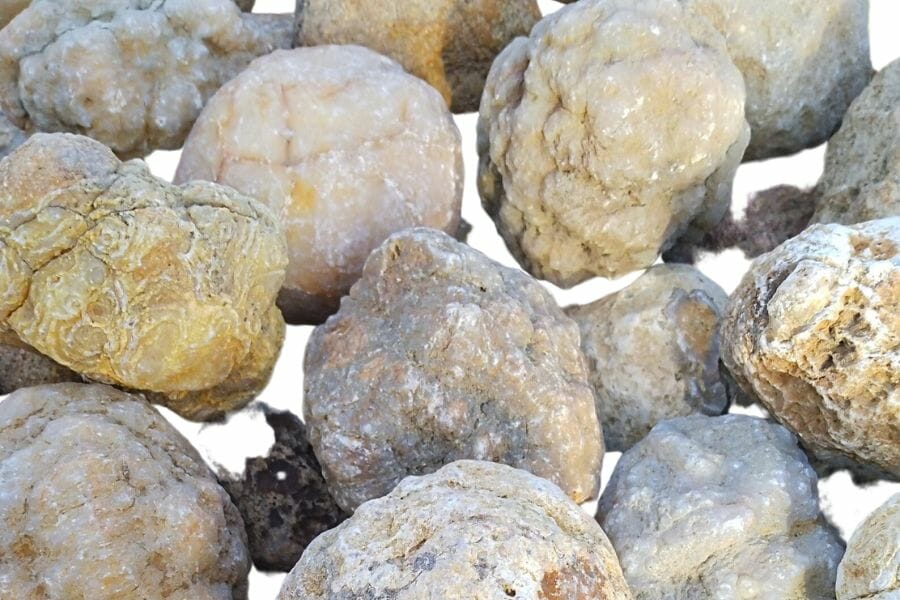
As you can see from the image above, geodes are typically round or oval-shaped and have a rough, bumpy exterior. Their size can range from a small pebble to several feet in diameter, and they can be found in a variety of colors and patterns.
One of the most distinguishing features of a geode is their hollow cavity, which is the result of gas bubbles getting trapped in the rock during its formation. This cavity is what makes geodes so unique and interesting.
Inside this cavity, you’ll find an array of crystals and minerals that are unique to each geode. These can include quartz, amethyst, calcite, and many others. Three great examples are included below:
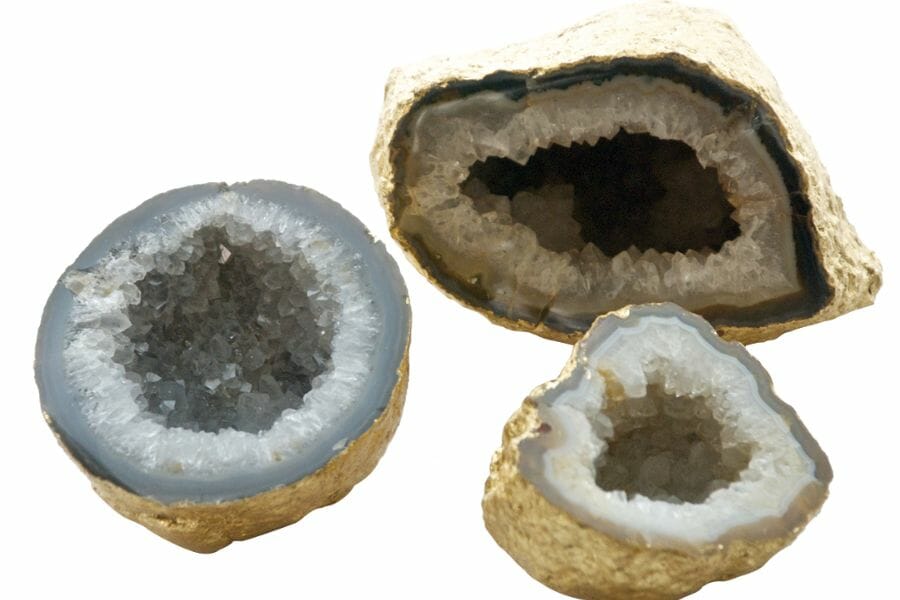
However, not all rocks with holes or hollow cavities are geodes. It’s important to look for certain characteristics to ensure that you’re dealing with a true geode. For example, geodes are typically found in clusters or groups, rather than as individual rocks. They are also usually found in areas with volcanic activity, such as old lava flows or ash beds.
Another characteristic to look for is the thickness of the exterior shell. Geodes have a thick, rough outer layer that is made up of different types of rock, such as limestone or basalt. This outer layer is what protects the crystals and minerals inside from weathering and erosion.
Geodes can also be formed in a variety of ways. Some are created when mineral-rich water seeps into a cavity in the rock and then evaporates, leaving behind crystals and minerals. Others are formed through volcanic activity, when hot lava flows over a cavity and then cools and hardens, creating a geode.
How to Tell the Difference Between a Geode and Other Rocks
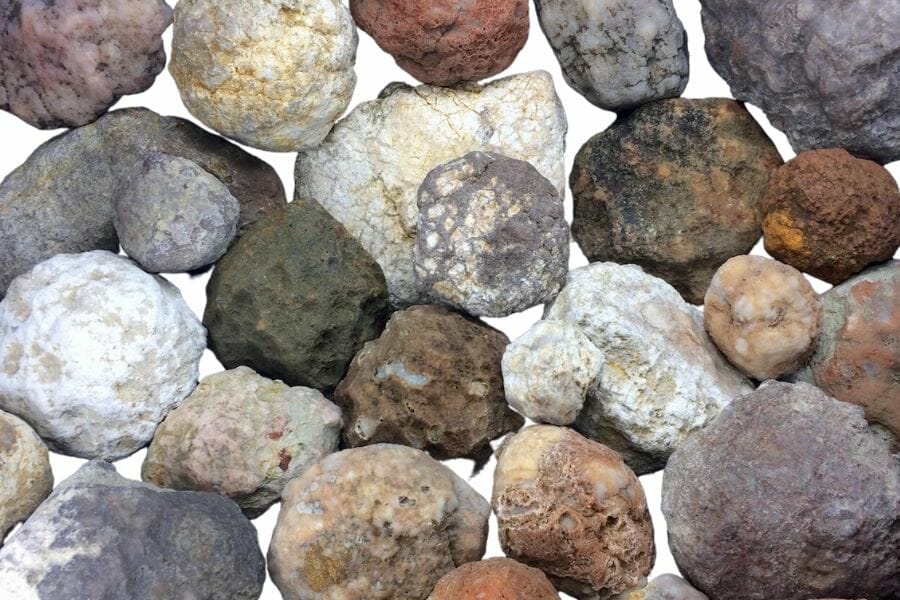
There are a few steps anyone can take to identify a geode 95% of the time without any special equipment or knowledge
Look for a rough and bumpy spherical rock
The first step in identifying a geode is examining its exterior. While geodes are typically rough and bumpy, they should also have a somewhat spherical shape. This is because the minerals and crystals inside have grown in a circular pattern around the air pocket.
When you look at the geodes in the image above the colors may differ but they are all roughly circular and bumpy. If the rock you’re examining is irregular in shape or looks like it’s been chipped away at, it’s likely not a geode.
It’s lighter (or heavier) than it looks
Another key characteristic to look for is weight. Geodes tend to be much lighter than other rocks of a similar size due to the cavity inside. If you pick up a rock and it feels surprisingly light, it may be a geode.
You do need to be careful though since this isn’t always the case. geodes differ on how much or how little empty space is inside of them. Some have very large cavities and feel very light while some are nearly completely filled and can feel as heavy (or heavier) than a typical stone that size.
This isn’t going to be a rule you can use every time but it’s something to keep in mind.
It sounds hollow when you tap it
Once you’ve found a rock that looks like it could be a geode, it’s time to put it to the test. Tap the rock gently with a hammer or another hard object. If it sounds hollow, it’s likely a geode. This is because the air pocket inside the rock creates an empty space that will produce a distinct sound when tapped.
It’s important to note that not all geodes are created equal. Some geodes are filled with beautiful crystals and minerals, while others may be relatively plain. Additionally, the colors and patterns inside a geode can vary widely depending on the location where it was formed and the minerals present in the water that created it.
So the next time you’re out exploring and you come across a rough, bumpy rock, take a closer look. It could be a geode waiting to be discovered!
How to Identify A Geode From The Outside
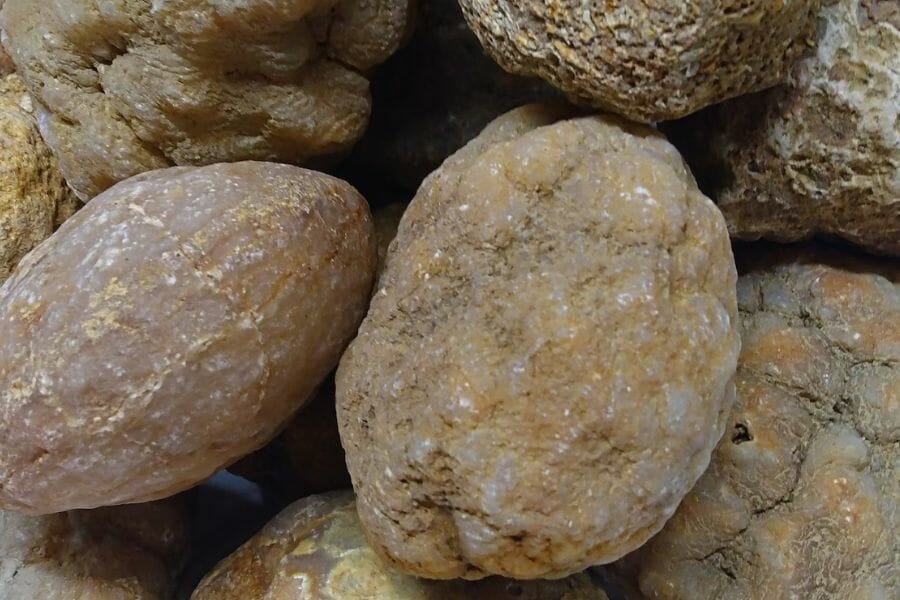
The exterior of a geode can tell you a lot about what’s inside as we discussed above. The most important features to look out for are:
A bumpy surface that might be shiny
A common feature of geodes is their rough, bumpy texture. This is caused by the outer layer of the rock forming first, and the inner layer taking longer to grow due to the trapped gases, often during formation from volcanic rock.
The bumps and ridges on the surface of a geode can also indicate the presence of crystals inside. If you run your hand over the surface of the rock and feel some roughness, it’s a good sign that you’re holding a geode.
If you look at the image above, you can see many bumps that look like they contain crystals. That’s always a good sign you have a geode on your hands.
Egg-shaped or spherical
Another characteristic of geodes is their shape. Geodes are typically round or oval-shaped, although some may be more oblong in shape. This is because the minerals inside the geode crystallize in a symmetrical pattern, creating a spherical or elliptical shape. If the rock appears to have an irregular shape, it’s not likely a geode.
However, it’s important to note that not all rough, bumpy rocks are geodes. Some rocks, such as volcanic rocks, can have a similar texture. To confirm whether a rock is a geode, you’ll need to crack it open and examine the inside.
Where You Are Most Likely To Find Geodes in the Wild
Being in an area where geodes naturally occur is key. Knowing how to identify a geode isn’t very valuable if you are in an area where they aren’t even found!
Geodes can be found all over the world, but some of the most famous locations for geode hunting include the American Midwest, Brazil, and Mexico. We have put together a complete guide to finding geodes that you should check out to find many different specific locations.
In the United States, geodes are commonly found in states such as Iowa, Missouri, and Kentucky. While geodes can be found all over the world, some areas are more abundant in them than others.
The typical places you will find geodes are:
Areas with a volcanic history
Geodes are often found in volcanic rocks, particularly in areas with a history of volcanic activity. They form in gas bubbles trapped within the lava as it cools and solidifies. Examples of such locations include Brazil, Mexico, and the United States (e.g., Oregon and Utah).
Sedimentary rock
Geodes can also form in sedimentary rocks like limestone and dolomite. They develop in cavities created by the dissolution of the surrounding rock or in spaces left behind by buried organic material.
One well-known example of geodes in sedimentary rocks is the “Keokuk geodes” found in the tri-state area of Iowa, Illinois, and Missouri.
Deserts
Some desert regions, such as the Mojave Desert in California and the Sonoran Desert in Arizona, are famous for their geode deposits. Here, geodes form as a result of groundwater percolating through the rock and depositing minerals in cavities.
Mining areas and mine dumps
Geodes can be found as a byproduct of mining operations, particularly in mines where minerals like quartz or amethyst are extracted.
What Does a Geode Look Like Inside?
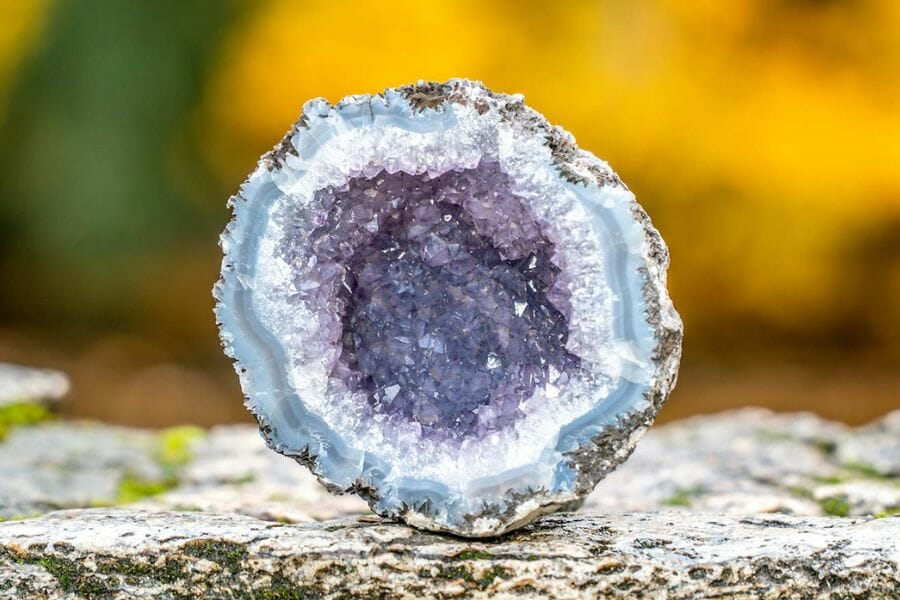
When you crack open a geode, you never know what you’re going to find. Some geodes have a uniform crystal pattern, with all of the crystals growing in the same direction and at the same rate. These geodes are often referred to as “cathedral” geodes because their crystal formations resemble the arches and buttresses of a Gothic cathedral.
Other geodes have a more chaotic interior, with a variety of minerals and colors on display. These geodes are often referred to as “agates” and can be particularly stunning. Agate geodes may have bands of different colors running through them, or they may have intricate patterns formed by the interplay of different minerals.
Some geodes, often called thundereggs, don’t have any cavities at all! They are completely filled with crystals and are quite beautiful. Below is an example of thundereggs.
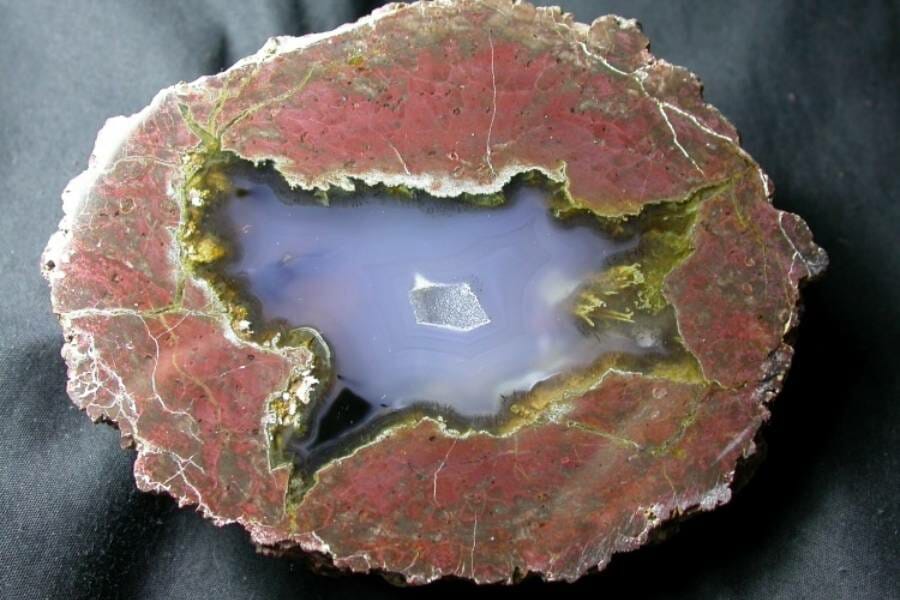
No matter what type of geode you find, one thing is for certain – they are truly a sight to behold. The intricate patterns and stunning colors on display in a geode’s interior are a testament to the beauty and complexity of the natural world.

